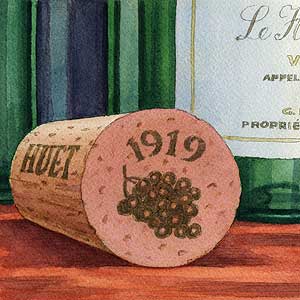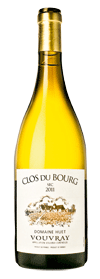Sale of the century


Roula Khalaf, Editor of the FT, selects her favourite stories in this weekly newsletter.
I’ve just been rereading what I wrote about my encounter with the late Gaston Huet, the most respected producer of Vouvray in the Loire. “He believes in hanging on to his wines for years before selling them,” I wrote in 1981. I suspect that even he might be surprised to see a wine as old as 1919 from his beloved Domaine Le Haut-Lieu being released by Berry Bros. By several curious turns of events, the London-based wine merchant is in the process of acquiring nearly 2,000 cases of grand old Huet Vouvrays. Along with Huet’s German importer Vinaturel, Berry Bros will be offering various combinations of this historic stock over the next few months and I would urge anyone interested in fully mature white wine to register their interest, or try the Wine Society, which has selected vintages.
Cheap Vouvray may be one of the nastiest of wines – equal and unresolved parts acid, sugar and sulphur – but Huet Vouvrays can be some of the greatest wines in the world, or at least they have been. There has been a small revolution at this historic domaine, which is why these wines are being put on sale now.
The domaine consists of three of the best vineyards in the Vouvray appellation, arguably the world’s Chenin Blanc capital. The Huet family bought the original vineyard, Le Haut-Lieu, with its old wine stocks, in 1928. When I visited Monsieur Huet in 1981 he was still enjoying the 1921s and 1913s. To Haut-Lieu’s 10 hectares, Gaston Huet added eight hectares of Le Mont in 1957 and the six-hectare Clos du Bourg in 1963. At that point, he felt he had acquired the crème de la crème of the appellation and had a domaine he could personally manage.
A quiet, bespectacled administrator, he had been mayor of Vouvray since the great 1947 vintage and gradually began adding more and more duties so that by the 1970s he was constantly in demand in Paris for meetings. How fortunate, then, that his daughter married Noël Pinguet, the ex-mathematician son of the local butcher who was already rather smitten with wine. From 1976 Noël steadily took over running the domaine from a father-in-law he described to me as “méticuleux et maniaque”. Noël was pretty meticulous and maniacal himself and by 1990 had won any family arguments about biodynamics to the extent that the domaine was now farmed entirely according to phases of the moon and without chemicals in the vineyard.
He became increasingly absorbed in how these new methods emphasised the different characters of their three vineyards, each of them on the plateau high above the river and facing south. Le Haut-Lieu around the original house and set back from the river has several metres of brown clay and produces the simplest and most forward wines (even though Pinguet managed to celebrate his 60th birthday with an 1893 Haut-Lieu). The longest-lived, most structured wines tend to come from Le Clos du Bourg, which has very shallow, well-drained, clay-limestone soils and is usually the first picked. Substantially replanted in the 1970s, it is responsible for particularly supple wines. Usually last picked is low-yielding Le Mont, whose compact, silex soils stretch in front of the house towards the Loire.
Classic Huet winemaking is the antithesis of, say, Chardonnay vinification. The last grapes may not be picked before November, ideally shrivelled to super-sweet raisins. The wines never see new wood but are fermented slowly in cellars that are by then pretty chilly. The second, softening malolactic fermentation is avoided at all costs and the wines put into bottle early, with eye-watering acidity, to do most of their maturing in glass. The acid level is more or less the same in all bottlings, but the amount of sugar in the grapes, and resulting wines, can vary enormously according to the season. There are four basic styles of still wine, as well as some gentle fizz labelled Perlant or Pétillant, which is one of the all-time great contributions to the canon of sparkling wine, the honey-and-apples character of Chenin producing something quite distinct from champagne.
Sec has residual sugar of 6-7 g/l. Most dry white wines have a sugar level under 2g/l but, says Pinguet, a Vouvray this dry “would be horrid for the first 20 years”. Demi-Sec Vouvray is one of my favourite styles. The sugar level is typically 20-25 g/l but all the acidity makes the wine taste just off dry. These sorts of wines, preferably with a bit of age, can be a beautiful match with creamy, savoury sauces. Then there is full-on sweet Moelleux, with between 40 and 60g/l of sugar, and occasionally an even sweeter Première Trie, made from the very ripest grapes.
In 2002 Gaston died. Death duties in France are well named. In 2003 a major share in the business was sold to Filipino-American businessman Anthony Hwang, who had already invested in an estate, Királyudvar, in another great centre of sweet winemaking, Tokaji in Hungary.
Then in February last year Noël Pinguet shocked le tout Vouvray and beyond by announcing his departure, three years before it had been planned when he reached 70. The estate is now run by his old team, aided and abetted by the next generation of Hwangs, Hugo (34) and Sarah (31). According to Noël, the Hwangs decided not to acquire the family stocks of wine comprising everything before 1975 plus wines from the great 1989 vintage – not necessarily just the best vintages but family anniversary years. According to Sarah, the Hwangs saw them as part of the family heritage of the man she lovingly refers to as “Mr Gaston” – and thought they had exclusive distribution rights whenever the time came to sell them. Apparently Noël decided otherwise. Sarah Hwang describes the day the old wines left the cellars (to be labelled and so on) as “a chilling day”. There is clearly ill feeling, accentuated by claims, disputed by her, that the Hwangs were putting pressure on Noël to produce more dry wine than he wanted to.
The last Pinguet vintage was 2011 – then, in both 2012 and 2013, the domaine suffered almost 50 per cent hail damage.

Noël Pinguet’s last Clos du Bourg Sec, the 2011, is already a charming, vibrant Loire Chenin – and £22.95 from Uncorked, London EC2 (020 7638 5998)
Tasting notes on Purple Pages of JancisRobinson.com
——————————————-
Jancis’s picks
I was lucky enough to taste 13 wines from the Huet family collection and my lowest mark was 16.5/20. The wines below, listed in declining score order, scored between 18 and 19.5.
• Le Haut-Lieu Première Trie Moelleux 1959
• Le Haut-Lieu Première Trie Moelleux 1989
• Le Mont Moelleux 1971
• Demi-Sec Pétillant 1969
• Le Haut-Lieu Demi-Sec 1957
Comments